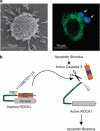How apoptotic cells aid in the removal of their own cold dead bodies
- PMID: 22421963
- PMCID: PMC3321633
- DOI: 10.1038/cdd.2012.25
How apoptotic cells aid in the removal of their own cold dead bodies
Abstract
Apoptotic cell clearance facilitates the removal of aged, damaged, infected or dangerous cells although minimizing perturbation of surrounding tissues, and is a vital process in the development and homeostasis of multicellular organisms. Importantly, failure to correctly execute programmed cell death and subsequent corpse clearance is broadly associated with chronic inflammatory and/or autoimmune diseases such as systemic lupus erythematosus. Apoptotic cells develop dramatic morphological changes including contraction, membrane blebbing and apoptotic body formation, which were among the first and most readily identifiable features of cellular suicide. However, understanding the purpose of apoptotic cell morphological changes has proven to be elusive, and recent studies have made somewhat surprising, and occasionally opposing, conclusions about the contribution of blebbing to phagocytic clearance and prevention of inflammatory/autoimmune disease. We review the evidence indicating how apoptotic blebs actively promote corpse recognition, uptake, and generation of auto-reactive antibodies.
Figures




References
-
- Orlando KA, Stone NL, Pittman RN. Rho kinase regulates fragmentation and phagocytosis of apoptotic cells. Exp Cell Res. 2006;312:5–15. - PubMed
Publication types
MeSH terms
Substances
Grants and funding
LinkOut - more resources
Full Text Sources
Other Literature Sources

